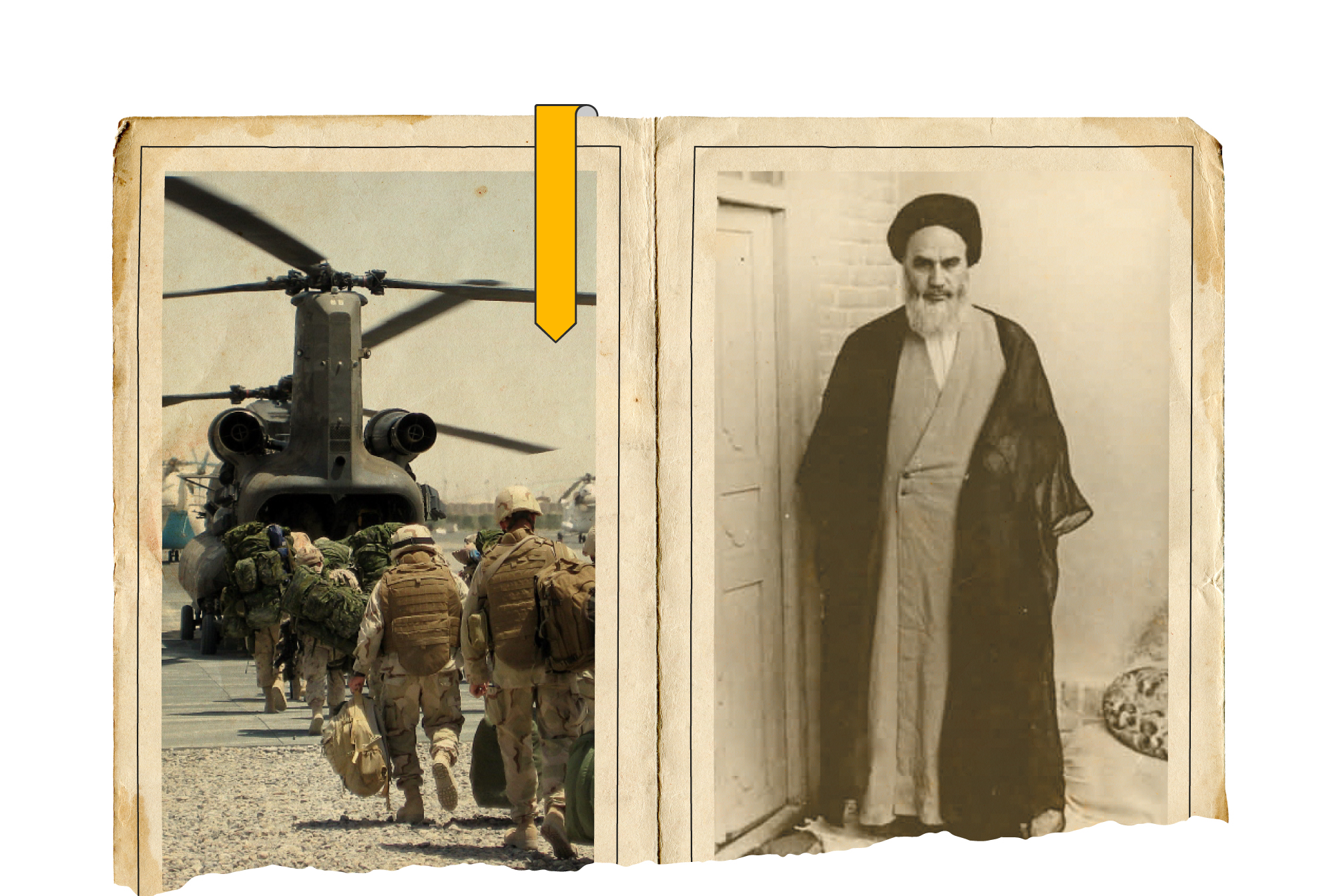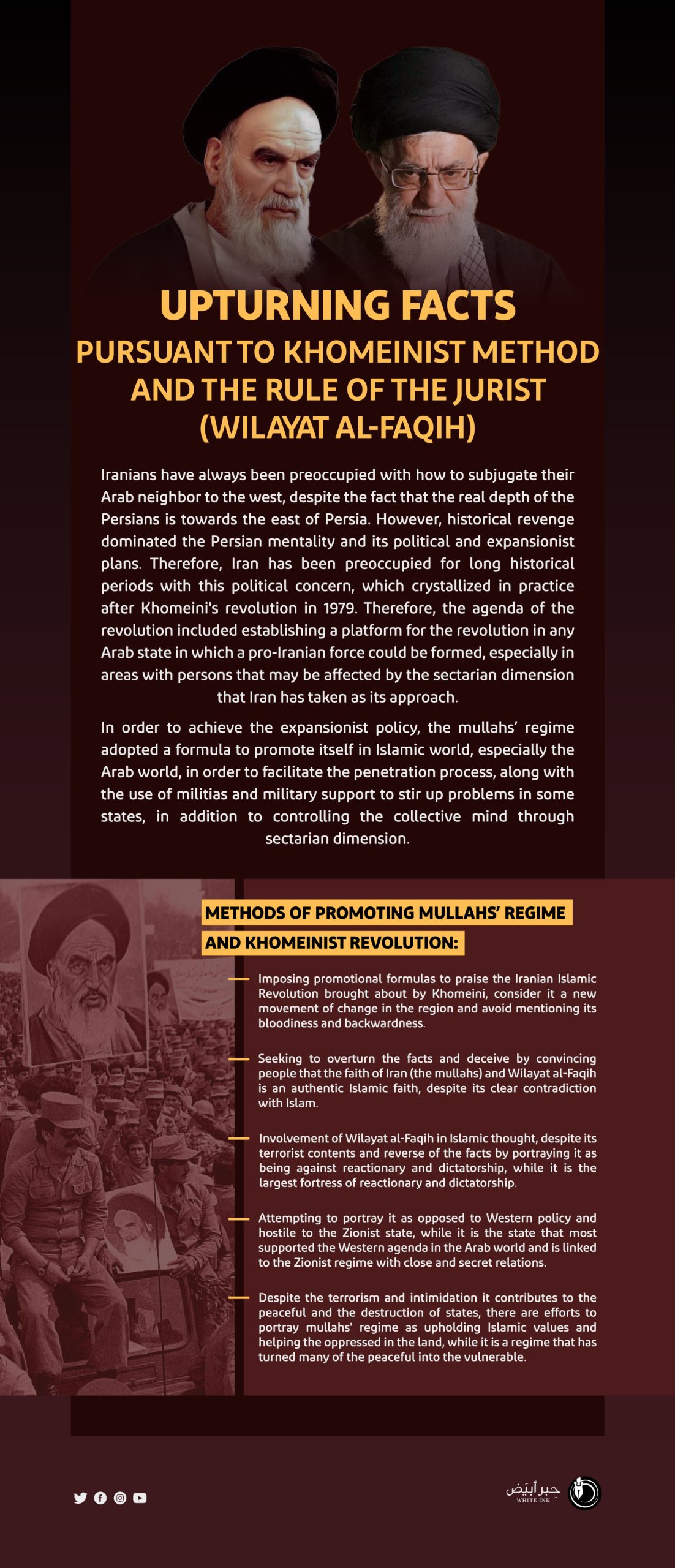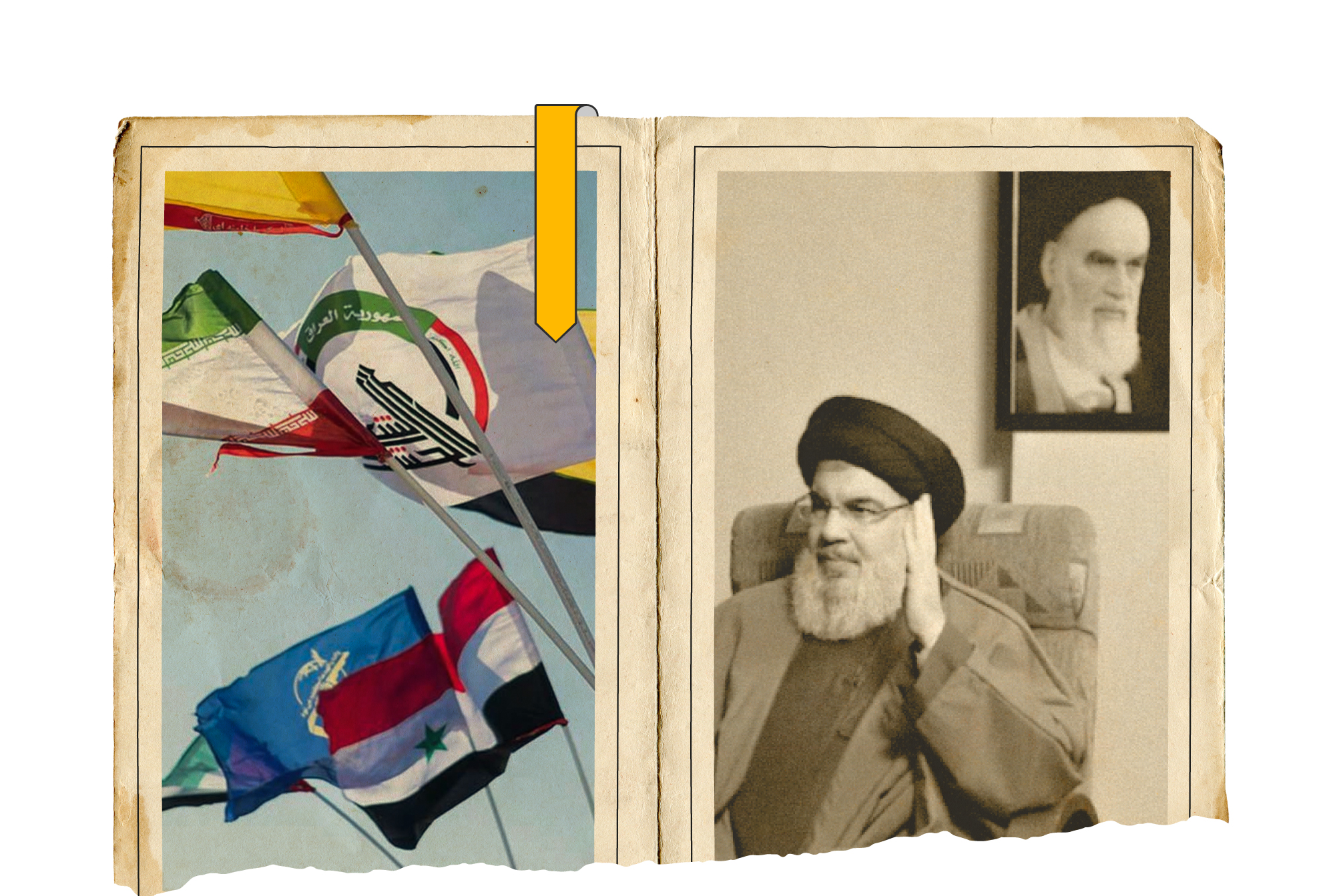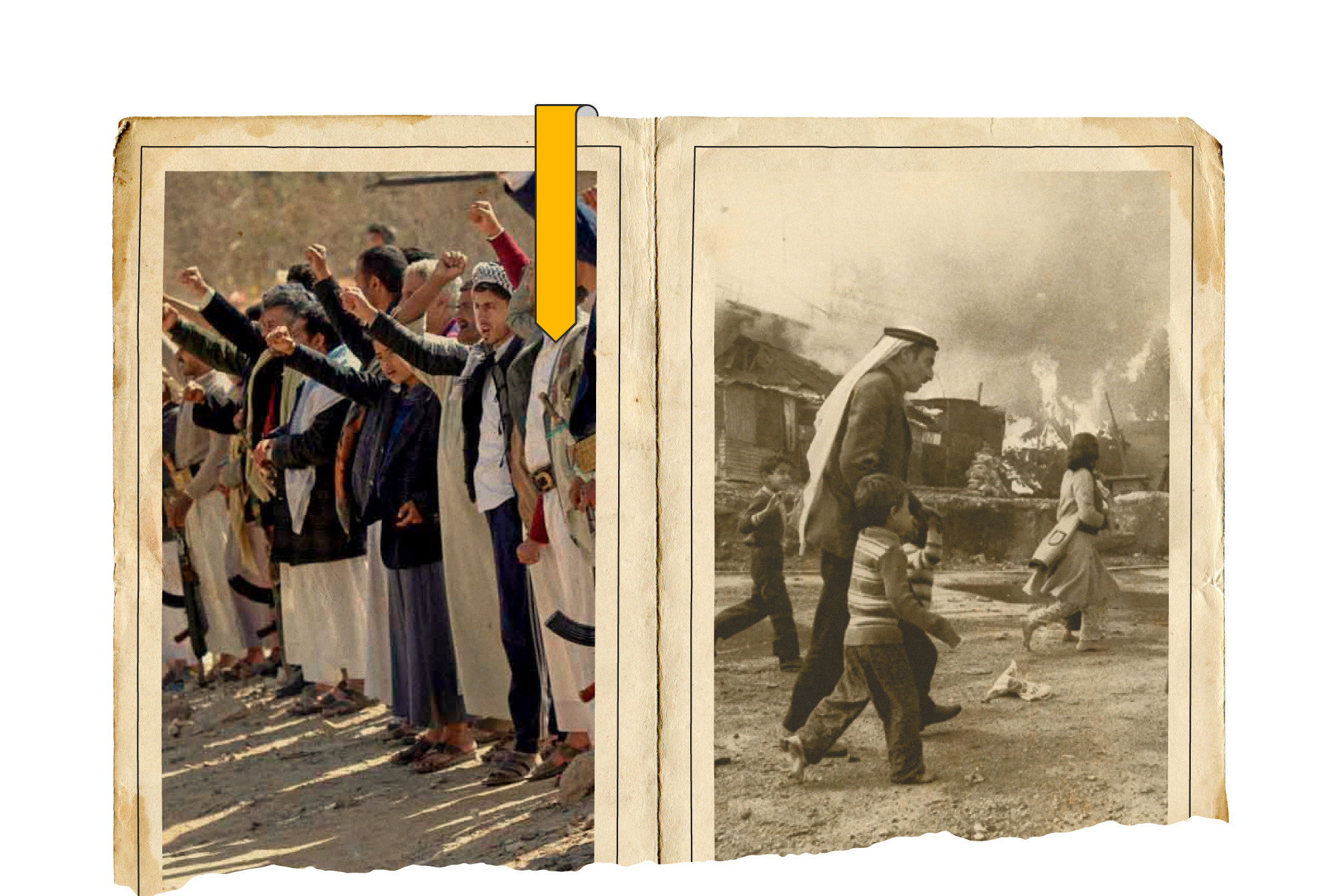
Draining their destinies for an impossible dream
Persian penetration of the Arab world caused a state of prolonged misery for the Iranian people
In the year (2003) the United States of America invaded Iraq and overthrew Saddam’s regime. That was a turning point in the history of Middle East, Especially since the matter happened with Iranian complicity in favor of America in its invasion of Iraq. It is noteworthy that the role of some Iraqi opponents, such as Ahmed Chalabi, in bridging the secret relations between Iran and the United States made Iran allow Iraqi opponents on its soil to work in favor of overthrowing the Iraqi regime, in an attempt to benefit from the state of political vacuum that Iraq and the Arab region witnessed after that invasion. Some described this matter as the United States presented a shattered Iraq and opened doors to Iran.
Radwan Al-Sayed confirmed this in his discussions with the American historian of Iranian origin, “Roy Mottahedeh”, saying: “Roy Mottahedeh was aware of the bitterness that ignited in all of us as a result of Iran’s role in the US occupation of Afghanistan and Iraq (2001-2003)”.
Within the framework of the strategic theory put forward by the Lebanese thinker Jamal Wakim about what he called “Iran’s historical tendency to reach the eastern Mediterranean”; Iran has attempted since that time to assert that it is the major regional power in the region, challenging the major traditional powers therein, which is confirmed by the future document prepared by what is known as the Expediency Council in Iran, in 2005, to transform Iran into a central regional power in South and West Asia region.
A new development appeared in the theory of exporting the revolution that Khomeini raised after his revolution (1979), as Iran worked to support political forces outside Iran, especially the radical forces hostile to the existing regimes in the Arab world, so as to establish Iranian-style governments. It also worked on exporting the “velayat-e faqih” concept in order to combine both religious and sectarian authorities to be combined and to refuse to separate them. From this point, Iran began to penetrate the region through some local forces supporting it, or associated with Iranian institutions, whether by virtue of sectarian affiliation or security connection. It also tried to benefit from the presence of some Shiite social groups in several states of the region in opening the door to Iranian presence. Iran also worked to trade in the religious concept of the Palestinian issue, which has become an essential axis in the Iranian propaganda machine.
As Radwan Al-Sayyed confirmed, since (2005) the relations between Iran and the Arabs have deteriorated as a result of Iran’s use of factors of religion, sect and power, so as to bring about division and fragmentation in Iraq, Syria, Lebanon, Bahrain and Yemen, linking the rise of the neo-conservative movement in America, its influence on the Middle East and the course of Iranian politics: “Just as the era between 2001 and 2009, which was the era of neoconservatism in American politics. It can be said without much exaggeration that it was the era of Iranian neoconservatism in Iran and its foreign policy”.
Thus, Iran was able, through its influence through the armed groups in Iraq, its support for the Syrian regime and its arm in Lebanon represented by Hezbollah, to gain a view of the eastern Mediterranean, confirming its old dream since the Persian Empire. Iran also entered into close relations with Hamas group that usurped Gaza Strip. Thus, Iran has a cat’s claw through which it can provoke Israel and bargain with it over its national security, if necessary. However, the most dangerous matter is also in Iran’s close relationship with Hamas because in that situation it became a threat to Egyptian national security, with its presence near Sinai and Suez Canal. Iran was also able, through its dubious relations with Houthi group in Yemen, and its unprecedented support for them, to pose a severe threat to freedom of navigation in Bab al-Mandab, the Red Sea gateway to Indian Ocean.
On the other hand, the American researcher of Arab origin, Walid Fares, points out an important and dangerous matter in terms of Iranian ambitions in the region, defining long-term goals of Iran in controlling Shiite-majority areas in the Arab world. The most dangerous of all is its attempt to assume conflict with the Kingdom of Saudi Arabia in order to try to achieve the “unified global Islamic legitimacy” declared by Khomeini when he declared the Islamic Republic in (1979).
Iranian officials were not convinced that Khomeini's ambitions to achieve a "unified world" under the authority of velayat-e faqih are a form of madness.

The Iranians realize that the Kingdom of Saudi Arabia, with its Arab and Islamic weight and dimension, is the one that can stand up to Iranian ambitions. As a result of Iran’s inability to confront directly with Saudi Arabia, Iran has resorted to the policy of “war by proxy”, as it opened several fronts in several directions with Kingdom Saudi Arabia, trying to open a front through Iraqi militias allied with Iran, so as to carry out operations against the Kingdom. However, this front was closed after the increased linkage in Saudi-Iraqi relations. As for Iranian front through the gangs of Houthi group as the Kingdom, within the Arab coalition and the support of Yemeni legitimate government, is facing this challenge with all capabilities.
The Iranians are proud of their blatant interference in Arab affairs. Iranian Supreme Leader Ali Khamenei boasted of the strategy of exporting the revolution to Lebanon, Syria, Iraq and Yemen, and even accused the United States of seeking to overthrow six Arab states in order to reduce what he called “Iran’s strategic depth”. On the other hand, this Iranian interference and the principle of exporting the revolution began to anger the Iranian interior, even some enlightened clerics in Iran. One of the Iranian mullahs says: “There is a belief that the money of the Iranian people is being spent in Lebanon, Yemen, Syria, and even Iraq, while the Iranian regime attributes the misery of the Iranian people to the issue of American embargo”.


- Jamal Wakim, Eurasia, the West, and Hegemony over the Middle East, (Beirut: Dar Abaad, 2016).
- Radwan Al-Sayed, Arabs and the Iranians: Arab-Iranian Relations in the Present Time (Beirut: Arab House for Science Publishers, 2014).
- Rashid Ahmed Al-Hunaiti, Principle of Exporting the Iranian Revolution and its Impact on the Stability of the Arab Gulf States, MA in Political Science, College of Arts and Sciences, Middle East University (2013).
- Carnegie Endowment, Sectarian Dilemmas in Iranian Foreign Policy, Asharq Al-Awsat Journal, 30 November 2016).
- Walid Fares, Scenarios of Iran’s War on the Arabs, Independent Arabia, 30 November 2021.


Within the Strategy of Mullahs' Rule in Iran
They used Arab issues to overthrow the ruling regimes and support their loyalists to come to power
On political and military, and even ideological, level, Persians strived to continue their mobilization against the Arabs, with the ultimate goal to control the Arab world and subjugate its states, which they believe will successively fall like dominoes, through the agenda they follow, presented in planting militias in some states.
In this context, the terminological definition directs us to argue that the phenomenon of penetration assumes “the participation of external parties, in conjunction with internal parties, in making political decisions within the infiltrated state in line with the goals of the penetrated state,” which is a fact that can be felt on the ground, especially since the mullahs came to power in (1979) on board a French plane and with Western blessing, no matter how some may claim to be apprehensive about the mullahs, who have always expressed great flexibility in meeting the demands of the West in a way that bypassed the strategic alliance that elevated the Shah to the rank of “Western Gendarmerie” in the region.
Despite the deep-rooted Persian hostility against everything that is Arab, the period of the Shah’s rule did not record a consistent strategy in antagonizing the Arabs, or a tendency to subjugate Arab states to Iran’s agenda, despite the Iranian intervention in some regions with the blessing of the West, as happened with the Sultanate of Oman. In return, the arrival of the mullahs to power made them adopt the Palestinian cause and the project of “exporting the revolution” in order to overthrow the Arab regimes, especially the monarchies, thus subjecting the region to the direct rule of mullahs of Iran.
Iranian penetration of the Arab region has always been in need of a fifth column inside those states, which Iran found in a part of the Shiite minorities who delusionally believed that there are sectarian intersections with Iran. Therefore, they strived to destroy their homes with their own hands and raised slogans of loyalty to the Persians. They embraced the doctrine of the guarding faqhi (successor of Sahib al-Zaman and his deputy), as claimed by Hassan Nasrallah, the head of the Lebanese “Hezbollah”.
Iran has striven to diversify the methods of infiltration and penetration, by resorting to soft power at times and, at other times, by working to create areas of savagery and manage them in a way that enables them to penetrate the region and attach them to Iranian influence, which is the same tactic used by terrorist organizations, which Abu Bakr Naji theorized in his book titled “Management of brutality”.
Western ally and the fifth column contributed to Iranian penetration of the Arab region.

However, brutality tactics adopted by the terrorist organizations (in their Sunni and Shiite manifestations) would not have succeeded in a strong state with historical, constitutional and legal legitimacy. Therefore, “Iran found in the crisis of building the Arab state an important means of penetrating the institutions of the official and unofficial authorities. This enabled it in many of its foreign arms; e.g., National Intelligence Agency, foreign embassies or social and religious development funds.
Iran’s direct or indirect penetration of the Arab states made it in control of the most important joints of the infiltrated state, thus owning the cornerstone of the political decision, ” sometimes it even came to recognizing or not recognizing the ruling institutions themselves” in light of the fragmentation of the political scene and the failure to circumvent a family or an Arab symbol capable of standing up to Iranian ambitions.
It can be said that the success of Iranian penetration in the Arab region was not necessarily based on or due to Iran’s military or political power, but rather the presence of a Western ally or groups that formed a fifth column within the Arab states. At this point, we record that a group of political Islam organizations and the rest terrorist organizations, whether those that claimed their affiliation to the Sunnis or the Shiites, were a malignant shovel that devoured many Arab and Islamic states.
Perhaps the love of reproduction and imitation has been empowered by some religious-political organizations that “expressed their influence on the Iranian revolutionary model and considered it a model that could be imitated. On its part, Iran embraced the principle of Islamic universalism and sometimes openly supported some Islamic movements. Therefore, the survival of the Islamic revolution in power in Iran in itself represents a source of support for many extremist Islamic groups, especially those of a violent nature”.
In sum, it can be said that we are facing three-dimensional conspiracies and parties against our Arab states, as well as a “triangle of evil”, which three sides are a lurking enemy (Iran), another complicit and conspirator (the West), and a third traitor and agent (the “Arab” political-religious organizations loyal to Iran). This prompts us to think of an integrated strategy that takes into consideration this malicious and conspiring trinity.


- Khaled Al-Mutlaq, Iranian Invasion of Arab States… Plans, Consequences and Solutions, Hermon Center for Contemporary Studies website (2021).
- Mahmoud Al-Jazi, Iranian Influence in Arab Region in Light of American Sovereignty Shifts Towards the Region 2003-2011 (Amman, Academics for Publishing and Distribution, 2014).
- Wasfi Aqeel and Khaled Al-Dabbas, Iranian Political Penetration of the Arab Neighboring Countries… A Case Study of Iraq, Bahrain, and Yemen, Journal of Humanities and Social Sciences Studies, Yarmouk University – Jordan, Vol. 45, p. 4 (2018).

Under the pretext of political and historical grievances
Entrances to Iranian penetration of Arab neighboring states
What is weird about Iranian politics and strategy is that it looks at the world through its western Arab borders, whom it hates and hopes for their demise, while its depth, race, heritage and language extend east to Khorasan, Baluchistan and Uzbekistan, and not to the west where the Arabs of Iraq, the Levant and the Arabian Peninsula are located. It is an incomprehensible situation in the political dimension, yet it is s understandable in its historical dimension, and the inherited hatred that destroyed Iran before it destroyed others. Hence, while nations devoted themselves to progress and development and forgot their historical empires that history buried hundreds of years ago, the Persians still dream of restoring the throne of Khosrau one day, yet neither did they restore it, nor they developed from their own state.
Iranian ambitions are not a result of the defining political moment that followed the Iranian revolution in 1979. It is a moment that completely turned the Middle East region around and transformed it from an Arab-Israeli conflict into another Arab-Iranian conflict. Although the Arabs never thought of contacting or conflicting with Iran since its joining Islam during the reign of Caliph Omar Ibn Al-Khattab (may Allah be pleased with him), yet it is the Iranians who carry greed and rivalry.
The Iranians are planning to expand beyond their historical borders, while the Arabs, unlike them, did not even try to recover their looted lands from the non-Arab border states in Ahvaz and Anatolia. However, this did not spare them as the greed for their lands and the fragmentation of their political and social structure is a major goal for the Iranians and others.
Political and historical grievances:
Iran is an expansionist state that lives on historical and political grievances because of the Arab victory in the Battle of al-Qadisiyah and the collapse of the king of Khosrau, thus the end of the Sasanian state forever. We find that this political grievance that bestowed the Iranian-Persian conscience later appears in the form of religious grievance. In the year (1500) and thereafter, after the Safavids spread the Twelver doctrine in its Persian form by force and reinforced through the religious grievance that they used, they are still using it to penetrate and capture the Arab conscience. In fact, it was nothing but a political movement to keep the battle open with the Arab opponents.
The Iranian war against the Arabs took two open paths; the first is revolutionary political and the other is sectarian, ultimately seeking to restore the dreams of the Persian Empire through these two bridges. In their expansionist ways, Persian Iranians were able to first seize the Arab coast of Ahvaz, with the help of the British, thus they controlled one bank of the Arabian Gulf. They are still planning to jump to the other bank that extends from Basra to Muscat, which is a solution that has turned into action on the ground through acting agents working in the interest of Iran, or by provoking regional chaos that Iran ignites whenever it is extinguished.
Nevertheless, an important question arises: Does the policy of the kings of Iran, whose rule fell with the departure of the Shah, differ from the mullahs?? The answer is: absolutely not. Bahrain, for example, and prior to the Iranian revolution, was the center of the ambitions of the Shah’s Iran. He almost swallowed it up and turned it into his territory under the pretext of recovering Persian property, as well as the Emirati islands that were occupied during the Shah’s era.
Soft or rough penetration:
Since its seizure of power in Tehran, Khomeini’s Iran has worked to crystallize the directions of its ruling political forces towards active participation in the region’s politics, which is confirmed by the future document prepared by the Expediency Council in 2005, to transform Iran into a central regional power.
On the legal level, Iranian constitution included provisions calling for the praise of Islamic Revolution as a new movement of change in the region, which contributed to the path of the authentic Islamic doctrinal renaissance. In its preamble, it also indicates clear texts on the importance of velayat-e faqih (Guardianship of the Jurist) in Shiite world, fighting reaction and dictatorship, spreading Islamic values and helping the oppressed, as they claim. After the pillars of the rule of “guarding jurist” as a clear institution in Iranian political system after the death of Khomeini, two major political currents emerged in Iran calling for Iran to take its regional position.
First: the hardline conservative current, which is mainly represented by the clerics who control the institution of velayat-e faqih (Guardianship of the Jurist), the Expediency Council and the leadership of the Revolutionary Guards, who rule by the method of the religious possessory system. Their hardline stances have emerged on the issues of presidential and parliamentary elections, the Iranian nuclear file, the Syrian crisis and support for the Lebanese Hezbollah. Their principles are based on the idea of using the ideological dimension based on revolutionary Islam concept as an influential factor in Iran’s foreign policy, rendering Iran the heart of Shiite Islamic world, rejecting foreign presence in the region.
Second: a current claiming diplomacy, calling itself a reformist, exchanging roles with the first and presenting an image of political reform to the Iranians.
Simultaneous nibbling policy:
Internal conditions that Iraq, Bahrain and Yemen went through played a major role in influencing their stability and continuity as national states. However, Iranian interventions and the deterioration of the economic and social structure in some of those states led to turning them into grounds ready to be tampered with by Iran, which worked to build a policy that we can call the simultaneous nibbling policy, i.e., intellectual expansion followed by a military expansion through local agents.
This was evident in Lebanon first, which was an important leap for Iran, where the civil war was already a factor in the 1980s, as well as the presence of a ready spearhead – i.e., parties with Iranian leanings such as Amal – which later helped build the terrorist organization Hezbollah that advanced to be an agent to Iran in Lebanon and was able to strangle the joints of the Lebanese state.
In Yemen, too, extremist Zaidis – they do not include the entire Zaidi sect – deceived Iran. However, there they were turned into agents and delegates who established the Houthi arm, which was initially formed as religious and sectarian schools, yet it was rapidly transformed into an armed organization.
In Iraq, which remained far from Iran until the fall of Baghdad in 2003, Iran embraced parties and organizations that it nurtured for two decades. Upon falling, it pushed them to the forefront of Iraq and, within months, those militias wiped out the face of Arab Iraq, or almost did.
This was not the only penetration into the Arab world. Iran intervened strongly in Bahrain and tried to overthrow the state with the help of extremist militias. Iran still insists on intervening in Bahrain and turning it into a liquidity zone that could collapse one day.
In his research published under the title “Iranian Expansion in the Arab World… Between Political Penetration and the Dream of the Shiite Expansion”, writer Safwat Jabr says: “Khomeini declared upon his arrival in Tehran in February 1979: We will export the ‘revolution’ to the whole world, so that everyone knows why we launched the revolution. Our goal was independence in the sense of liberation from restrictions and dependence on the East and West, and freedom. Our revolution must be exported to all parts of the world. Exporting the revolution is to wake up all peoples and governments” This is how Ayatollah Khomeini formulated the new Iranian ideology.
Arab transformations and revolutions helped Iran to interfere in the affairs of some Arab states. This is clearly evident in Iranian expansion in many Arab states. The more sectarianism and civil wars increased, the more active are the Iranian role and the Revolutionary Guards in the Arab world states. Meanwhile, the weakness of Arab institutions and organizations gave Iran a golden opportunity to replace the Arab role therein and replace it with Iranian one.
Transitions and revolutions helped Iran to interfere in the affairs of some Arab states.

Iran is good at the political hit-and-run game with the Arab side. At a time when it is expanding in Yemen, Syria and Iraq, killing its opponents of the Kurds and the People’s Mujahideen of Iran, we find it flirting with the Arabs through statements about reconciliation work or strategic agreements. However, it simultaneously supports the armed opposition in the Arab states through its militias.


- Khaled Al-Mutlaq, “The Iranian Invasion of Arab States… Plans, Destinations, and Solutions,” Hermon Center for Contemporary Studies website (2021).
- Safwat Jabr, “Iranian Expansion in the Arab World… Between Political Penetration and the Dream of the Shiite Tide! Iranian Foreign Policy Since the Islamic Revolution of 1979”, Adwaa Journal for Research and Studies, Baghdad (2021).
- Mahmoud Al-Jazi, “Iranian influence in the Arab region in light of the shifts in American sovereignty towards the region 2003-2011” (Amman. Academics for Publishing and Distribution, 2014).
- Wasfi Aqeel and Khaled Al-Dabbas, “Iranian Political Penetration of Arab Neighboring States… A Case Study of Iraq, Bahrain and Yemen,” Journal of Humanities and Social Sciences Studies, Yarmouk University – Jordan, vol.45, p.4 (2018).





